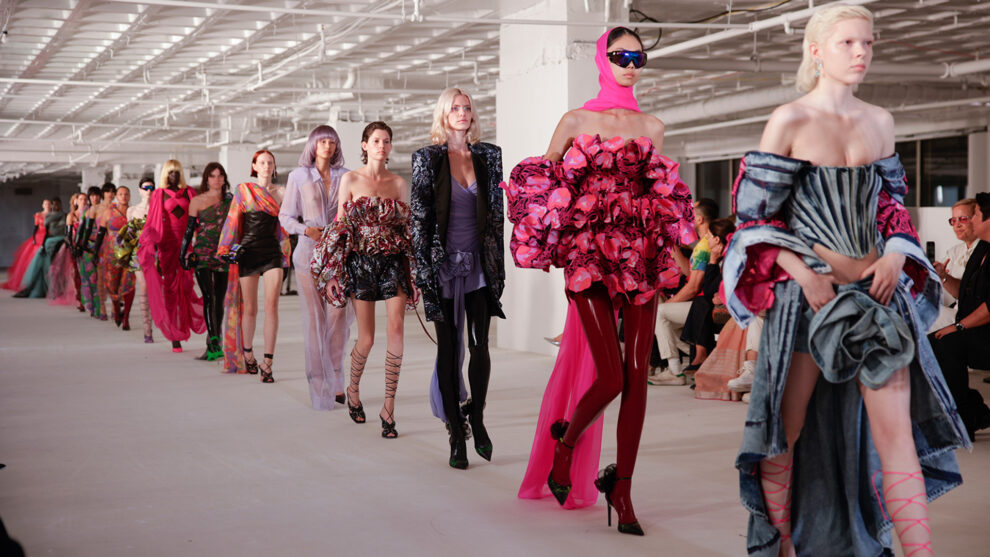FashionUnited has been summarising the fashion industry’s efforts towards greater sustainability month by month for five years now. Reason enough to take a look back over the years before drawing conclusions for 2023.
While 2019 was characterised by individual efforts, such as the development of recyclable and more environmentally friendly products in the sports and denim sectors, due to the Corona pandemic, 2020 was initially more about survival than sustainability. However, this already changed in the second half of the year, when sustainability was seen as a way out of the crisis and brands, retailers and other industry players stepped up their efforts. The general slowdown in the industry that was called for was unfortunately short-lived.
2021 was still heavily overshadowed by the pandemic, but the industry realised that lone wolves don’t get far – the call for unity and cooperation became louder. However, membership in intra-industry and cross-industry alliances should not be a substitute for efforts at an individual level; similarly, half-hearted initiatives or only supposedly sustainable ones were less tolerated – “greenwashing” established itself as a term and “greenwashers” were increasingly called out.
This trend continued in 2022. Euphemisms and calling projects or initiatives “green” when they are not was no longer accepted, even if done out of ignorance. Demands for legal action against greenwashing became stronger. In addition, in view of the growing mountains of discarded clothing and textiles, the industry was focussing more on textile-to-textile recycling or on technologies that can tackle the issue mechanically and chemically.
Sustainability round-up 2023
This brings us to 2023, which was characterised by extremes – instead of a general slowdown in the industry, it is further divided with ultra-fast fashion on one side, which speeds up production even more, and ultra-slow fashion on the other, which not only produces less, but also calls for non-consumption and initiatives such as repair, swap and resale – Green Friday is becoming a trend.
Joint initiatives continue to be popular, as the industry has recognised that it is stronger when united and can achieve more, including greater transparency. Germany is looking back on one year of the Supply Chain Act (LkSG), which came into effect on 1st January 2023, to guarantee that companies do not benefit from child and forced labour and other abuses along their supply chain. The European regulation is about to be finalised with the forthcoming EU Supply Chain Act. There is a general call for more legal regulation in terms of sustainability. How did this come about? Follow the developments in the 2023 annual review.
December
In December, the fashion industry stepped up its sustainability efforts once again: These were discussed at the COP28 climate conference, among others, but various studies also scrutinised supposedly sustainable initiatives such as biomass and textile collections for recycling purposes. Textile-to-textile recycling received a boost while greenwashing was called out.
November
In November, the industry increased its efforts to become more transparent – for example through certain standards, but also through clearer communication on the brand side, for instance regarding the true cost of an item of clothing. Consumers, on the other hand, seem to be paying less and less attention to the aspect of sustainability when shopping.
Various industry events were dedicated to sustainability and the circular economy and Black Friday is increasingly becoming Green Friday – more and more brands are taking part. FashionUnited also visited a textile recycling facility in Wormerveer in the Netherlands.
October
In October, there was some food for thought that let the industry pause for a bit. For example, behavioural scientists from the University of Amsterdam and the Amsterdam University of Applied Sciences suggested that the Dutch government ban advertising for fast fashion. In California, a new law obliges large companies to disclose their greenhouse gas emissions – but not until 2026. A background article explained what the fashion industry has to do with microplastic pollution and what we should know about the EU initiatives to combat these microplastics.
September
In September, in addition to trade fairs such as the Fashion Transparency Summit, prizes such as the Sustainable Fashion Award, brand initiatives and partnerships on the topic of sustainability, two individual efforts stood out: Alex Dabagh, founder of the New York bag label Anybag, wants to revolutionise textile production by reusing single-use plastic, and entrepreneur Thomas Hebenstreit wants to turn the menswear market in India upside down with his shirt label The Shirt Dandy, using European expertise and Indian tailoring. In future, consumers in the EU should also be able to better recognise whether a product is sustainable and how easy it is to repair.
August
August was characterised by individual efforts and innovations as part of the Green Product Awards as well as partnerships – for example between Under Armour and Hemp Black and Soex and Circular Republic. More and more companies are saying ‘no’ to kangaroo leather – such as Nike, Adidas and soon Puma.
The minimalism/frugality trend is also stirring up controversy and is currently encouraging people to declutter, especially when it comes to their wardrobes. However, experts advise that minimalism should be turned from a private pleasure into a phenomenon, so that something changes on a larger scale too.
July
While the month of July beckoned with some warm summer weather, the European Commission’s annual report on sustainability revealed some unpleasant truths: For example, the European Court of Auditors found that the transition to a circular economy had virtually stalled despite the ten billion euros made available to EU member states to promote a circular economy.
The European Commission also published an updated Waste Framework Directive (WFR) focussing on textile waste. This is intended to support the separate collection of textile waste, which will be mandatory in the EU from 2025, and promotes circular textile technologies such as fibre-to-fibre recycling. However, it is not far-reaching enough and does not set specific targets for reuse and recycling, which the Changing Markets Foundation calls a “missed opportunity”.
The leather debate also flared up again in July: While Desserto inventors Adrián López Velarde and Marte Cázarez Duarte continued to develop their leather alternative made from cactus (nopal) and presented the first agave-based vegan ‘leather’, FashionUnited asked an expert on the topic of leather and sustainability. In an interview with PETA, it emerged that cruelty to animals is built-in when using animal products.
June
June was all about exchanging information – about new materials, EU legislation and pioneers such as Allbirds, Freitag and Arda Biomaterials, who are driving sustainability in the textile and clothing industry. Sustainability was not neglected at the Global Fashion Summit either. FashionUnited summarised the European Parliament’s legislative initiatives to tackle the negative social and environmental impact of the industry.
May
May was characterised by recycling and upcycling initiatives from brands like Nat-2 and Aku and textile innovations by TomTex and UPM Biochemicals, as well as a new standard from the Textile Exchange. The environmental organisation Greenpeace also published a greenwashing study to examine how sustainable the industry and its brands and retailers really are. Various European cities signed a declaration against fast fashion at the end of the month.
April
April turned out to be one of the most active and promising months of the year. It was dominated by Earth Day on 20th April, Fashion Revolution Week, which commemorated the tenth anniversary of the collapse of the Rana Plaza building in Bangladesh on 24th April 2013, and the World Retail Congress from 25th to 27th April in Barcelona, which focused on sustainability, transparency, traceability and responsibility, among other things.
Probably the best news, however, came from MEPs on the European Parliament’s Environment Committee: they are working on tighter regulations and calling for an end of fast fashion, which promots excessive production and consumption. Instead, MEPs want to encourage European Union countries to produce circular, sustainable and socially responsible textiles that are more durable, easier to reuse, repair and recycle.
March
March awaited with highlights: A study showed that social media is one of the most influential sources of sustainability information for consumers, and Amsterdam lingerie label Love Stories and Dutch designer Tess van Zalinge presented how upcycled wedding dresses and vintage veils can be turned into underwear.
The most innovative approach in March was offered by Dutch clothing brand New Optimist, which introduced a deposit system on its clothing. In the middle of the month, Tomo opened in the Westfield Mall in the Netherlands, which is nothing unusual so far. However, it sees itself as a “department store with a mission” that wants to motivate consumers to participate in the circular economy. In this month, FashionUnited also made a contribution with a new sustainable fashion section that aims to promote knowledge sharing in the industry.
February
February was a mixed bag and perhaps a bit frustrating: while on the one hand, the industry joined initiatives and made efforts to become more circular, on the other hand, it is struggling with its legacy: huge mountains of discarded textiles in Ghana, for example, or consumers who pay more attention to price than to sustainability when choosing a product.
In addition, the tripling (!) of used clothing exports from the EU is causing problems in Africa and Asia. However, a plastic-eating enzyme could tackle polyester clothing waste and plastic from Indian waste collectors has been processed into millions of buttons.
January
Industry pioneers shared their experiences with innovation processes in January for example the Dutch brand Kuyichi, Asket and Lindex from Sweden and fashion brand ETP. Mud Jeans and Kings of Indigo demonstrated how to recycle denim.
Efforts also continued in the areas of resale, clothing exchange and second-hand. The European Fashion Alliance, which was founded last year and aims to drive the necessary change in the European fashion industry, presented results at its first summit.
Sustainable trade fairs such as Beyond Fashion Berlin and Innatex also recorded good success and collaboration initatives such as Fashion for Good are driving innovation. While sustainable influencers are taking on fast fashion, the EU Commission is planning a law against greenwashing.
Source: Fashion United






















